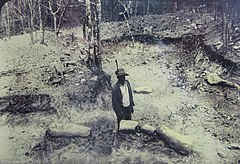| Tendaguru Formation | |
|---|---|
| Stratigraphic range: ?Callovian-Hauterivian ~ | |
 | |
| Type | Geological formation |
| Sub-units | See text |
| Underlies | Makonde Formation |
| Overlies | Neoproterozoic gneiss basement |
| Thickness | >110 m (360 ft) |
| Lithology | |
| Primary | Sandstone |
| Other | Shale, siltstone, clay, conglomerate, limestone |
| Location | |
| Coordinates | 9°42′S 39°12′E / 9.7°S 39.2°E |
| Approximate paleocoordinates | 29°24′S 16°42′E / 29.4°S 16.7°E |
| Region | Lindi Region |
| Country | |
| Extent | Mandawa Basin |
| Type section | |
| Named for | Tendaguru Hill |
| Named by | Janensch & Hennig |
| Year defined | 1914 |

The Tendaguru Formation, or Tendaguru Beds are a highly fossiliferous formation and Lagerstätte located in the Lindi Region of southeastern Tanzania. The formation represents the oldest sedimentary unit of the Mandawa Basin, overlying Neoproterozoic basement, separating by a long hiatus and unconformity. The formation reaches a total sedimentary thickness of more than 110 metres (360 ft). The formation ranges in age from the late Middle Jurassic to the Early Cretaceous, Oxfordian to Hauterivian stages, with the base of the formation possibly extending into the Callovian.
The Tendaguru Formation is subdivided into six members; from oldest to youngest Lower Dinosaur Member, the Nerinella Member, the Middle Dinosaur Member, Indotrigonia africana Member, the Upper Dinosaur Member, and the Rutitrigonia bornhardti-schwarzi Member. The succession comprises a sequence of sandstones, shales, siltstones, conglomerates with minor oolitic limestones, deposited in an overall shallow marine to coastal plain environment, characterized by tidal, fluvial and lacustrine influence with a tsunami deposit occurring in the Indotrigonia africana Member. The climate of the Late Jurassic and Early Cretaceous was semi-arid with seasonal rainfall and the eustatic sea level was rising in the Late Jurassic from low levels in the Middle Jurassic. Paleogeographical reconstructions show the Tendaguru area was located in the subtropical southern hemisphere during the Late Jurassic.
The Tendaguru Formation is considered the richest Late Jurassic strata in Africa. The formation has provided a wealth of fossils of different groups; early mammaliaforms, several genera of dinosaurs, crocodyliforms, amphibians, fish, invertebrates and flora. More than 250 tonnes (250 long tons; 280 short tons) of material was shipped to Germany during early excavations in the early twentieth century. The faunal assemblage of the Tendaguru is similar to the Morrison Formation of the central-western United States, with an additional marine interbed fauna not present in the Morrison.
The dinosaur fauna found in the formation is similar to that of other highly fossiliferous stratigraphic units of the Late Jurassic; among others the Kimmeridge and Oxford Clays of England, the Sables de Glos, Argiles d'Octeville, Marnes de Bléville of France, the Alcobaça, Guimarota and Lourinhã Formations of Portugal, the Villar del Arzobispo Formation of Spain, the Shishugou, Kalazha and Shangshaximiao Formations in China, the Toqui Formation of Chile and Cañadón Calcáreo Formation and the Morrison Formation, with the presence of dinosaurs with similar counterparts, e.g., Brachiosaurus and Stegosaurus in the Morrison, and Giraffatitan and Kentrosaurus in the Tendaguru.[1]
- ^ Mateus, 2006, pp.223–232
